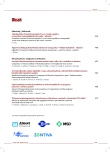Is there a hope in pharmacological treatment of thromboembolic pulmonary hypertension?
Authors:
J. Widimský
Authors‘ workplace:
Klinika kardiologie IKEM Praha, přednosta prof. MUDr. Jan Kautzner, CSc., FESC
Published in:
Vnitř Lék 2009; 55(5): 517-522
Category:
Reviews
Overview
Chronic thromboembolic pulmonary hypertension that used to be treated with anticoagulation therapy only had serious prognosis. The five-year survival of patients with the mean pulmonary artery pressure above 50 mm Hg was just 10%. The introduction of pulmonary endarterectomy in clinical practice represented a significant improvement in patient prognosis. However, about 1/3 of patients have distal lesions and are thus not eligible for surgery. In addition, the surgery is not indicated in a number of patients due to serious co-morbidities. Even though milder, pulmonary hypertension persists in 10–15% of post‑surgery patients. About 50% of patients are candidates for pharmacological vasodilatation treatment. To summarize the current knowledge of pharmacotherapy in these patients, the open-label studies provide limited information as they were conducted on small patient samples and were not blinded. The only large prospective blinded study of treatment with bosentan, BENEFiT, confirmed that there is a reduction of pulmonary vascular resistance after 16 weeks of treatment. However, bosentan did not affect exercise tolerance. Furthermore, the study follow up was 16 weeks only. Observational data from the British national registry of chronic thromboembolic pulmonary hypertension suggest that up to 72–77% of patients are pharmacotherapy candidates. Furthermore, the British registry data show significantly better survival of patients treated recently, in 2003 and beyond (treated mostly with bosentan or sildenafil), and thus provide an important indirect evidence of the positive effect of pharmacotherapy, particularly in comparison to our data from 1982 that show the natural course of chronic thromboembolic pulmonary hypertension before the introduction of pulmonary endarterectomy in clinical practice and before modern pharmacotherapy.
Key words:
chronic thromboembolic pulmonary hypertension – pharmacotherapy – pulmonary endarterectomy
Sources
1. Simonneau G, Galie N, Rubin L et al. Clinical classification of pulmonary arterial hypertension. J Am Coll Cardiol 2004; 43 : 5S–12S.
2. The Task Force on diagnosis and treatment of pulmonary arterial hypertension of the European Society of Cardiology. Guidelines on diagnosis and treatment of pulmonary arterial hypertension. Eur Heart J 2004; 25 : 2243–2278.
3. Jansa P, Aschermann M, Riedel M et al. Doporučení pro diagnostiku a léčbu plicní hypertenze v ČR. Cor Vasa 2004; 46: K35–K44.
4. Hoeper M, Mayer E, Simonneau G et al. Chronic thromboembolic pulmonary hypertension. Circulation 2006; 113 : 2011–2020.
5. Fedullo PF, Auger WR, Kerr KM et al. Chronic thromboembolic pulmonary hypertension. Review article. N Engl J Med 2001; 345 : 1465–1472.
6. Widimský J. Chronické důsledky akutní plicní embolie. Cor Vasa 2006; 48 : 317–320.
7. Pengö V, Leasing AW, Prins MH et al. Incidence of chronic thromboembolic pulmonary hypertension after pulmonary embolism. N Engl J Med 2004; 350 : 2257–2264.
8. Becattini C, Agnelli G, Pesavento R et al. Incidence of chronic thromboembolic pulmonary hypertension after first episode of pulmonary embolism. Chest 2006; 130 : 172–175.
9. Riedel M, Staněk V, Widimský J et al. Long‑term follow‑up of patients with pulmonary thromboembolism: late prognosis and evolution of hemodynamic and respiratory data. Chest 1982; 81 : 151–158.
10. Jamieson SW, Kapelanski DP, Sakakibara N et al. Pulmonary endarterectomy: experience and lessons learned in 1500 cases. Ann Thorac Surg 2003; 76 : 1457–1462.
11. Lindner J, Jansa P, Kunštýř J et al. Endarterektomie plicních tepen – chirurgická léčba chronické tromboembolické plicní hypertenze. Čas Lék čes 2005; 145 : 307–312.
12. Freed DH, Thomson BM, Tsui SSI et al. Functional and haemodynamic outcome 1 year after pulmonary thrombendarterectomy. Eur J Cardiothorac Surg 2008; 34 : 525–530.
13. Condliffe R, Kiely DG, Gibbs JS et al. Improved outcomes in medically and surgically treated chronic thromboembolic pulmonary hypertension. Am J Respir Crit Care Med 2008; 177 : 1122–1127.
14. Ghofrani HA, Schermuly RT, Rose F et al. Sildenafil for long‑term treatment of non‑operable chronic thromboembolic pulmonary hypertension. Am J Respir Crit Care Med 2003; 167 : 1439–1441.
15. Reichenberger F, Voswinckel R, Enke B et al. Long‑term treatment with sildenafil in chronic thromboembolic pulmonary hypertension. Eur Respir J 2007; 30 : 922–927.
16. Hoeper MM, Kramm T, Wilkens H et al. Bosentan therapy for inoperable chronic thromboembolic pulmonary hypertension. Chest 2005; 128 : 2363–2367.
17. Hughes RJ, Jais X, Bonderman D et al. The efficacy of bosentan in inoperable chronic thromboembolic pulmonary hypertension: a 1. year follow‑up study. Eur Respir J 2006; 28 : 138–143.
18. Vassallo FG, Kodric M, Scarduelli C et al. Bosentan for patients with chronic thromboembolic pulmonary hypertension. Eur J Intern Med 2009; 20 : 24–29.
19. Ono F, Nagaya N, Okanuta H et al. Effect of an active prostacyclin analogue on survival in patients with chronic thromboembolic pulmonary hypertension without major vesel obstruction. Chest 2003; 123 : 1583–1588.
20. Suntharalingam J, Treacy C, Doughty N et al. Long‑term use of sildenafil in inoperable chronic chronic thromboembolic pulmonary hypertension. Chest 2008; 134 : 229–236.
21. Jais X, D’Armini AM, Jansa P et al for the BENEFiT Study Group. Bosentan for treatment of inoperable chronic thromboembolic pulmonary hypertension. BENEFiT (Bosentan Effects in iNopErable Forms of chronic Thromboembolic pulmonary hypertension), a Randomized, Placebo-Controlled Trial. J Am Coll Cardiol 2008; 52 : 2127–2134.
Labels
Diabetology Endocrinology Internal medicineArticle was published in
Internal Medicine

2009 Issue 5
Most read in this issue
- Extrinsic allergic alveolitis – rarely diagnoticated disease
- Turner’s syndrome requires multidisciplinary approach
- Comparison of various methods of body fat analysis in overweight and obese women
- Turner syndrome is associated with increased cardiovascular morbidity and mortality
